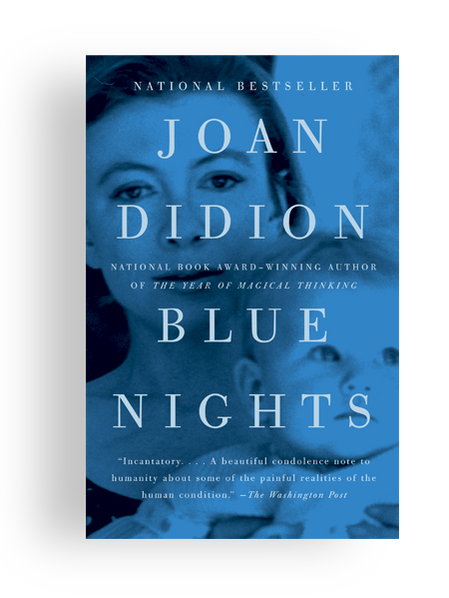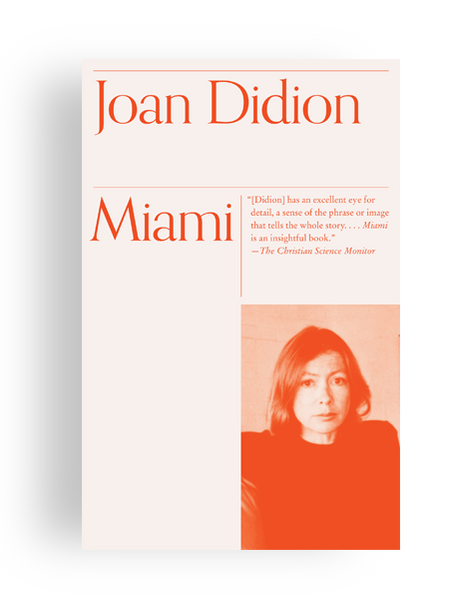The White Album
ESSAYS
June 19, 1979
Publication Date:
Publisher:
FSG Classics
ABOUT THE BOOK
From a jailhouse visit to Black Panther Party cofounder Huey Newton to witnessing First Lady of California Nancy Reagan pretend to pick flowers for the benefit of news cameras, Didion captures the paranoia and absurdity of the era with her signature blend of irony and insight. She takes readers to the “giddily splendid” Getty Museum in Los Angeles, the cool mountains of Bogotá, and the Jordanian Desert, where Bishop James Pike went to walk in Jesus’s footsteps—and died not far from his rented Ford Cortina. She anatomizes the culture of shopping malls—“toy garden cities in which no one lives but everyone consumes”—and exposes the contradictions and compromises of the women’s movement. In the iconic title essay, she documents her uneasy state of mind during the years leading up to and following the Manson murders—a terrifying crime that, in her memory, surprised no one.
Written in “a voice like no other in contemporary journalism,” The White Album is a masterpiece of literary reportage and a fearless work of autobiography.
Read an Excerpt
We tell ourselves stories in order to live. The princess is caged in the consulate. The man with the candy will lead the children into the sea. The naked woman on the ledge outside the window on the sixteenth floor is a victim of accidie, or the naked woman is an exhibitionist, and it would be “interesting” to know which. We tell ourselves that it makes some difference whether the naked woman is about to commit a mortal sin or is about to register a political protest or is about to be, the Aristophanic view, snatched back to the human condition by the fireman in priest’s clothing just visible in the window behind her, the one smiling at the telephoto lens. We look for the sermon in the suicide, for the social or moral lesson in the murder of five. We interpret what we see, select the most workable of the multiple choices. We live entirely, especially if we are writers, by the imposition of a narrative line upon disparate images, by the “ideas” with which we have learned to freeze the shifting phantasmagoria which is our actual experience.
Or at least we do for a while. I am talking here about a time when I began to doubt the premises of all the stories I had ever told myself, a common condition but one I found troubling. I suppose this period began around 1966 and continued until 1971. During those five years I appeared, on the face of it, a competent enough member of some community or another, a signer of contracts and Air Travel cards, a citizen: I wrote a couple of times a month for one magazine or another, published two books, worked on several motion pictures; participated in the paranoia of the time, in the raising of a small child, and in the entertainment of large numbers of people passing through my house; made gingham curtains for spare bedrooms, remembered to ask agents if any reduction of points would be pari passu with the financing studio, put lentils to soak on Saturday night for lentil soup on Sunday, made quarterly F.I.C.A. payments and renewed my driver’s license on time, missing on the written examination only the question about the financial responsibility of California drivers. It was a time of my life when I was frequently “named.” I was named godmother to children. I was named lecturer and panelist, colloquist and conferee. I was even named, in 1968, a Los Angeles Times “Woman of the Year,” along with Mrs. Ronald Reagan, the Olympic swimmer Debbie Meyer, and ten other California women who seemed to keep in touch and do good works. I did no good works but I tried to keep in touch. I was responsible. I recognized my name when I saw it. Once in a while I even answered letters addressed to me, not exactly upon receipt but eventually, particularly if the letters had come from strangers. “During my absence from the country these past eighteen months,” such replies would begin.
This was an adequate enough performance, as improvisations go. The only problem was that my entire education, everything I had ever been told or had told myself, insisted that the production was never meant to be improvised: I was supposed to have a script, and had mislaid it. I was supposed to hear cues, and no longer did. I was meant to know the plot, but all I knew was what I saw: flash pictures in variable sequence, images with no “meaning” beyond their temporary arrangement, not a movie but a cutting-room experience. In what would probably be the middle of my life I wanted still to believe in the narrative and in the narrative’s intelligibility, but to know that one could change the sense with every cut was to begin to perceive the experience as rather more electrical than ethical.
During this period I spent what were for me the usual proportions of time in Los Angeles and New York and Sacramento. I spent what seemed to many people I knew an eccentric amount of time in Honolulu, the particular aspect of which lent me the illusion that I could any minute order from room service a revisionist theory of my own history, garnished with a vanda orchid. I watched Robert Kennedy’s funeral on a verandah at the Royal Hawaiian Hotel in Honolulu, and also the first reports from My Lai. I reread all of George Orwell on the Royal Hawaiian Beach, and I also read, in the papers that came one day late from the mainland, the story of Betty Lansdown Fouquet, a 26-year-old woman with faded blond hair who put her five-year-old daughter out to die on the center divider of Interstate 5 some miles south of the last Bakersfield exit. The child, whose fingers had to be pried loose from the Cyclone fence when she was rescued twelve hours later by the California Highway Patrol, reported that she had run after the car carrying her mother and stepfather and brother and sister for “a long time.” Certain of these images did not fit into any narrative I knew.




















